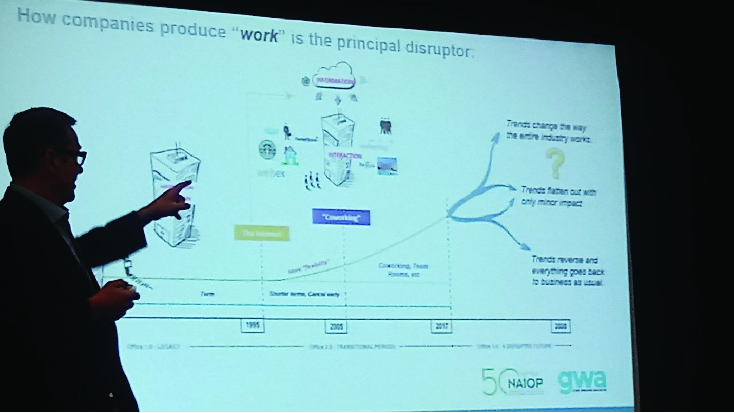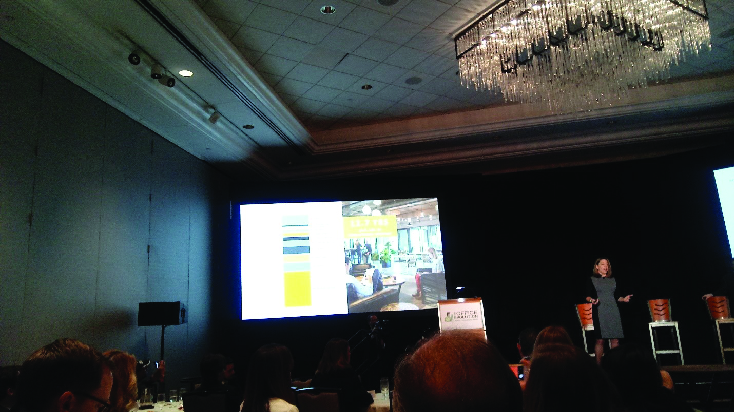Hurricane Irma may have blown out plans for a sun-kissed gathering in South Beach, but GWA’s Office Evolution Conference successfully pivoted. Hosted in Brooklyn, NY alongside NAIOP (Commercial Real Estate Development Associations) the three-day conference was full of tours, talks and opportunities for exchange among flexible workspace owners and operators.
NAIOP’s presence added a great deal of value to the content. Experts from CBRE, Gensler, Convene, Delos, Industrious, Serendipity Labs, and various others addressed topics from a landlord’s perspective and also presented useful and informative content on the future of work and the workplace.
Below you will find several key takeaways from The Office Evolution Conference.
- The physical workplace is one of the primary drivers of job satisfaction, which is why human resource directors are increasingly getting involved in decisions relative to work environments. Ryan Simonetti from Convene explained that those responsible for developing strategies to attract and retain workers are powerful decision-makers. A point he illustrated by sharing an anecdote of a recent bid to manage amenity space at High 5 Gaming. The story goes that the human resources director called for the two finalist companies to put on a party, and employees later voted for their favorite one. The winning firm got the contract–it’s an entire new way of doing business.
- Research from NAIOP and Convene showed that common spaces provide opportunities to create value for landlords, operators, and users via amenity programs. Activating spaces with amenities and programming such as outdoor workspaces, food trucks, happy hours, and speakers creates opportunities for socialization among tenants; as well as the option to work beyond the tenant’s suite. Convene’s program at One World Trade Center spans 25,000 square feet of amenities, including a micro-brew coffee shop, grab-and-go café, work lounges, flexible meeting and event space, game rooms, and curated community and wellness programming.

Jeffrey Langdon of Adaptive Office Resources explaining the emergence of Office 3.0. - Private offices are preferred in coworking spaces. As the percentage of enterprise customers increases in the coworking world, the popularity for shared and open space offices declines. Conference attendees toured the Yard’s newest facility in Brooklyn, comprised completely of enclosed offices. They also heard from Serendipity Labs, Industrious, and other flexible operators that focus primarily on offering private offices.
- Agility models drive commercial real estate when it comes to Office 3.0. Corporations are no longer maintaining long-term strategies, but instead consulting 3 to 5-year plans. Office 3.0 is not about real estate, rather it’s about workplace infrastructure, products and services.
- Suburban setting provides opportunities for flexible working. John Abuja of Marcus & Millichap and Mark Fitzgerald of USAA Real Estate Company shared that, contrary to popular belief, 70% of millennials live in the suburbs, as does 64% of the overall population. To be competitive with central business districts, suburban settings must have access to talent, technology, and transportation. These areas should also offer amenities like fitness centers, child care, urgent care, conference centers and outdoor space in order to make a more competitive offer.
- Creative financing options exist for coworking operators, with funding available from asset owners, venture capitalists, lenders, and strategic investors. Other opportunities include partnerships and licensing with developers as Mara Hauser of 25N and Nick Clark of Common Desk shared in a case study.
- The office hasn’t changed much, but the way we work has. This has shifted shifted tenant needs and wants, therefore changing what owners must provide. Today’s workplace is experience-driven and technologically enabled, and the future of office will operate like a full-service hotel, with curated experiences. In other words: the landlords customer today is the employee, not the company.
- Choice, flexibility, and experiences are what millennials value the most; this has helped fuel the growth of flexible spaces as part of a business’ strategy. JLL estimates that flexible workspace comprises about 30% of commercial office space today, though others estimate it somewhere between 20% and 60%.

Julie Whelan presenting CBRE research on Agility Factors - Despite options to work anywhere, 71% of employees prefer to work from the office, said Andrew Garner-Wortzel, sharing research from Gensler Experience Index, giving rise to innovative spaces that are designed to support agile teams by cutting-edge technology.
- The agile workforce has changed the way we view the workplace. About 67% of businesses globally are now choosing different forms of flexible workspace as a long-term strategy, rather than a temporary solution.
- People are working, eating, socializing, exercising, and shopping everywhere; thus traditional uses of space types are blurring. according to Julie Whelan of CBRE, it’s the employer’s responsibility to provide an omnichannel office: seamless channels for employees that can and will work anywhere and at any time.
- Flexible offices are here to stay. According to JLL’s Workspace Reworked report, 30% of office space will be flexible by 2030. NAIOP predicts this will happen by 2022 in Space-as-a-Service.


 Dr. Gleb Tsipursky – The Office Whisperer
Dr. Gleb Tsipursky – The Office Whisperer Nirit Cohen – WorkFutures
Nirit Cohen – WorkFutures Angela Howard – Culture Expert
Angela Howard – Culture Expert Drew Jones – Design & Innovation
Drew Jones – Design & Innovation Jonathan Price – CRE & Flex Expert
Jonathan Price – CRE & Flex Expert










